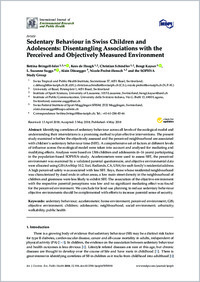Sedentary behaviour in Swiss children and adolescents : disentangling associations with the perceived and objectively measured environment
- Bringolf-Isler, Bettina Swiss Tropical and Public Health Institute, Socinstrasse 57, 4051 Basel, Switzerland - University of Basel, Petersplatz 1, 4051 Basel, Switzerland
- De Hoogh, Kees Swiss Tropical and Public Health Institute, Socinstrasse 57, 4051 Basel, Switzerland - University of Basel, Petersplatz 1, 4051 Basel, Switzerland
- Schindler, Christian Swiss Tropical and Public Health Institute, Socinstrasse 57, 4051 Basel, Switzerland - University of Basel, Petersplatz 1, 4051 Basel, Switzerland
- Kayser, Bengt Institute of Sport Sciences, University of Lausanne, 1015 Lausanne, Switzerland
- Suggs, L. Suzanne Istituto di comunicazione pubblica (ICP), Facoltà di scienze della comunicazione, Università della Svizzera italiana, Svizzera
- Dössegger, Alain Swiss Federal Institute of Sport Magglingen SFISM, 2532 Magglingen, Switzerland
- Probst-Hensch, Nicole Swiss Tropical and Public Health Institute, Socinstrasse 57, 4051 Basel, Switzerland - University of Basel, Petersplatz 1, 4051 Basel, Switzerland
- The SOPHYA Study Group Swiss Tropical and Public Health Institute, Socinstrasse 57, 4051 Basel, Switzerland
-
04.05.2018
Published in:
- International journal of environmental research and public health. - 2018, vol. 15, no. 5, p. 918
Sedentary behaviour
Accelerometer
Home environment
Perceived environment
GIS
Objective environment
Children
Adolescents
Neighbourhood
Social environment
Urbanicity
Walkability
Public health
English
Identifying correlates of sedentary behaviour across all levels of the ecological model and understanding their interrelations is a promising method to plan effective interventions. The present study examined whether the objectively assessed and the perceived neighbourhood are associated with children’s sedentary behaviour time (SBT). A comprehensive set of factors at different levels of influence across the ecological model were taken into account and analysed for mediating and modifying effects. Analyses were based on 1306 children and adolescents (6–16 years) participating in the population-based SOPHYA-study. Accelerometers were used to assess SBT, the perceived environment was examined by a validated parental questionnaire, and objective environmental data were allocated using GIS (ArcMap 10.2, Esri, Redlands, CA, USA) for each family’s residential address. A high perceived safety was associated with less SBT. Boys, those whose residential neighbourhood was characterized by dead ends in urban areas, a low main street density in the neighbourhood of children and greenness were less likely to exhibit SBT. The association of the objective environment with the respective parental perceptions was low and no significant mediating effect was found for the perceived environment. We conclude for land-use planning to reduce sedentary behaviour objective environments should be complemented with efforts to increase parental sense of security.
- Language
-
- English
- Classification
- Medicine
- License
- Open access status
- gold
- Identifiers
-
- RERO DOC 328316
- DOI 10.3390/ijerph15050918
- ARK ark:/12658/srd1319112
- Persistent URL
- https://n2t.net/ark:/12658/srd1319112
Statistics
Document views: 171
File downloads:
- Texte intégral: 170
